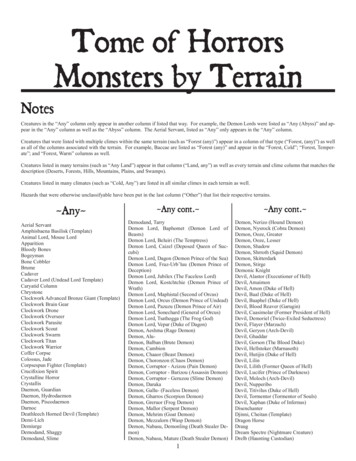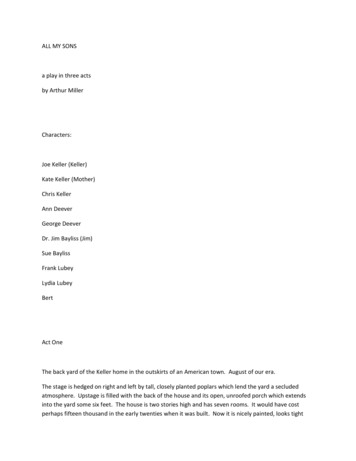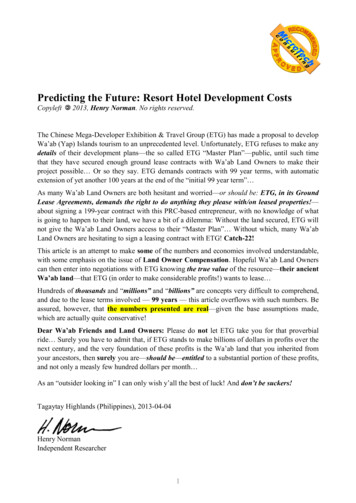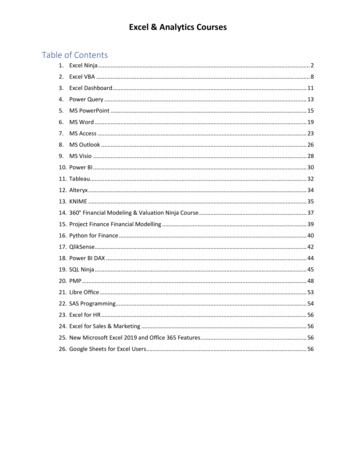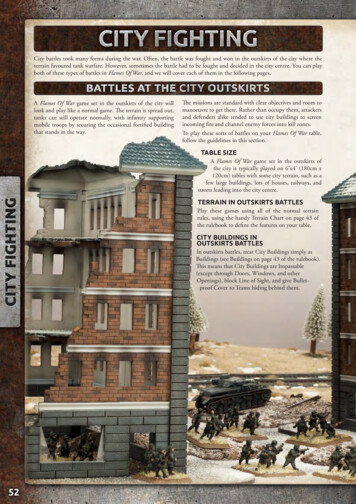
Transcription
City battles took many forms during the war. Often, the battle was fought and won in the outskirts of the city where theterrain favoured tank warfare. However, sometimes the battle had to be fought and decided in the city centre. You can playboth of these types of battles in Flames Of War, and we will cover each of them in the following pages.A Flames Of War game set in the outskirts of the city willlook and play like a normal game. The terrain is spread out,tanks can still operate normally, with infantry supportingmobile troops by securing the occasional fortified buildingthat stands in the way.The missions are standard with clear objectives and room tomanoeuvre to get there. Rather than occupy them, attackersand defenders alike tended to use city buildings to screenincoming fire and channel enemy forces into kill zones.To play these sorts of battles on your Flames Of War table,follow the guidelines in this section.TABLE SIZEA Flames Of War game set in the outskirts ofthe city is typically played on 6'x4' (180cm x120cm) tables with some city terrain, such as afew large buildings, lots of houses, railways, andstreets leading into the city centre.TERRAIN IN OUTSKIRTS BATTLESPlay these games using all of the normal terrainrules, using the handy Terrain Chart on page 43 ofthe rulebook to define the features on your table.CITY BUILDINGS INOUTSKIRTS BATTLESIn outskirts battles, treat City Buildings simply asBuildings (see Buildings on page 43 of the rulebook).This means that City Buildings are Impassable(except through Doors, Windows, and otherOpenings), block Line of Sight, and give Bulletproof Cover to Teams hiding behind them.52
To avoid confusion and keepthings simple, all measurementsfor movement and shooting shouldbe horizontal, just the distance onthe tabletop ignoring any verticalcomponent.Line of Sight is still checked usingWYSIWYG (What You See IsWhat You Get), so it there's a clearline between two teams, they cansee each other If one of the teamsis in an elevated position, then theywill be able to see and be seen overlower terrain as usual.When Charging into Contact, theAssaulting teams move as close asthey could get to a Defending teamas usual. An Assaulting team is InContact with teams above or belowit if it would be In Contact withthem if they were on thesame level.Ignore the vertical distancewhen Charging into Contact,so the Assaulting Team is InContact with this team.The buildingwall stops theAssaulting Teamfrom touchingthe DefendingTeams, so theyhalt at the wall,but are still inContact as theAssaulting teamis as close as theycan get to theDefending team.The Assaulting Team would be closerto this Team if it moved into theCity Building, so is not In Contactwith it.53
If the skirmishes in the suburbs fail to decide the fate of acity, the fight rages on into the built-up urban areas within.Here the battle is fought in brutal, relentless close quarters combat.BATTLES IN THE INNER CITYWhen armies were forced into street fighting, the gamechanged and the toll was high. Often, whole companies orbattalions of infantry were focused entirely on a single building, clearing rooms one-by-one with specialist equipment,like submachine-guns and flame-throwers. Tanks, while stillquite powerful, were not as critical to success as the infantryin the rubble-strewn streets. Still, their high-calibre gunswere essential for knocking out machine-gun nests andstrongpoints that hold up the assault troops.The following section offers some rules that you can use torecreate these desperate urban fights.TABLE SIZECity fighting chewed up a huge amount of troops in verysmall areas. Multi-storey city buildings and rubble terraindrastically decreased the ground a company could hold ortake, making achievable tactical objectives a matter of abuilding or two, rather than miles or kilometres.In Flames Of War, this means the battlefield yourcompany-sized formations are fighting over is a smaller areathan usual. The terrain will be rough, and city buildings adda whole new dimension to the battlefield, with new tacticaloptions and challenges.From both story and gameplay points of view, tabletop innercity battles should use up to 4' x 4' (120cm x 120cm)of table space to keep the focuson a few critical buildings. Youcan simply use a portion of yournormal 6'x4' (180cm x 120cm)table to play your games, or use asmaller table instead.MAMAYEVKURGANThe Mamayev Kurganwas a steep and rockyhill that dominated theStalingrad landscape.If you want to add asimilar hill to your citybattle, treat it as a SteepHill (see Hills on page43 of the rulebook).Of course, other parksand hills are alsoappropriate terrain incity landscapes.INCOMPLETE BUILDINGSWalls and corners that do not make a completeCity Building are considered free-standing walls.Therefore, they are treated simply as Exterior Walls(see Buildings on page 43 of the rulebook).54
CITY BUILDINGSWhether it's a tractor factory, a chemical plant, a grain elevator, or a block of apartments, large multi-storey buildingstake centre stage in urban combat. Whole battles rage withinthe four walls of a single building as the troops fight roomto-room to capture these critical buildings.City Buildings are a major part of inner city battlefields inFlames Of War. These buildings are much larger than yourtypical houses or town buildings. The following pages offersome rules for city buildings on your urban table.BOULEVARDSBoulevards are wide streets in cities that are divided bytramlines, footpaths, or tree lines down the centre of theroadway. This is a good way to add some linear terrainand some cover for your troops crossing wide city streets.TANKS AND GUNS IN CITY BUILDINGSTanks and Large Gun Teams cannot deploy or move intoa City Building.Other Gun teams can deploy on the ground floor of a CityBuilding, but cannot move once positioned and cannotdeploy on upper floors.CITY STREETSRUBBLERubble is Difficult Terrain for Movement andShort Terrain for determining concealment. It alsoprovides Bulletproof Cover for Teams completelyinside it. See Buildings on page 43 of the rulebook.City Streets are rubble-strewn and damaged, so Teamsmove across them at Tactical or Terrain Dash only.Digging into streets requires a lot of hard work andtime, making it impractical to do so during the battle.Teams cannot Dig In or start the game in Foxholes onCity Streets.55
CITY BUILDINGSImagine the CityBuilding is complete withfour walls and the modelon the table is a cut-awayrepresentation so that youcan see inside and haveeasy access to the troops.Teams up along theoutline of the Buildingbenefit from the protection of walls as thoughthey were there.City Buildings block Lineof Sight through them,regardless of the shape ofthe Building's walls.INTERIOR WALLS& ROOMSA City Building hasone or more Rooms.Rooms should bebetween 4”/10cm and6”/15cm across.Rooms should be markedout by interior wallsinside the City Buildingshown clearly on theground floor.The ground floor, and allfloors directly above it,are one Room.In this example, theCity Building has a totalfour Rooms.56
ADJACENT ROOMSRooms are Adjacent toeach other if they sharea common wall. Roomslocated diagonally acrossa corner are not Adjacentto each other.The Room occupied by this Sovietteam is not Adjacent to this Room.The Room occupied by thisSoviet team is Adjacent tothese rooms.UPPER LEVELSThe upper levels wholeor partial floors thathave space to hold oneor more Teams above theground floor. These levelsallow you to add moretroops into a Room thancould normally fit on theground floor.The ground floor andall upper levels are allpart of the same Room.57
OCCUPYING A ROOMThe main difference about fightingin City Buildings is how Teamsoccupy Rooms.Once a Team has moved completelyin a Room (it can't stop halfway in),the whole Room is now occupied.Measure all distances to and fromthe edge of the Room rather than theTeams in it. For instance, this means: Teams outside the Buildingcannot move within 2"/5cm of aRoom occupied by the enemy, Teams move Room-to-Room ratherthan a measured distance.MOVING BETWEEN ROOMSOnce inside aRoom, verticalmovementwithin it is free.A Team cannot enterand exit a Room in thesame Step.Once a Team has moved into aRoom, any further Movement withinthe Room is free, including up anddown floors (although it still countsas Movement) and can be done whilePinned Down.A Team cannot enter and exit aRoom in the same Step.MOVING NEAR THE ENEMYINSIDE CITY BUILDINGSTeams cannot enter a Room occupiedby the enemy, but can move freely inRooms Adjacent to enemy-occupiedRooms.A Team cannot enter aRoom occupied by anenemy Team.IN COMMANDA Team is In Command if it endsits Move with its Unit Leader in thesame or an Adjacent Room.Unit Leaders outside the CityBuilding measure commanddistance as normal to the Roomsoccupied by the Unit's Teams.Unit Leaders inside the CityBuilding measure commanddistance to Teams outside as normal,measuring from any Opening in theexternal walls of that Room.58Teams outside theBuilding measurecommand distance toany of the Openings ofthe Room occupied bythe Unit Leader.
Teams in a City Building are alwaysConcealed and in Bulletproof Cover,even for Defensive Fire.SHOOTING INTO BUILDINGSIf a Team has range and Line of Sightto an Opening into a Room in a CityBuilding, it has range and Line ofSight to every Team in that Room.Otherwise, there is no Line of Sightinto a City Building.SHOOTING OUT OFBUILDINGSAll Infantry Teams in a Room canshoot out of any Opening in thatRoom. Gun Teams must have theirfront Adjacent to an Opening inan external wall to shoot out ofthe Building. Only Teams entirelyin front of the wall containing theOpening are in its Field of Fire.Teams outside the building cansee through Openings into Rooms,but cannot see through a Room toanother Rooms.SHOOTING IN A BUILDINGInfantry Teams have Range and Lineof Sight to all Teams in an adjacentRoom, but not in Rooms that arenot Adjacent.All Teams are fighting at point-blankranges and therefore the target playercannot use the Mistaken Target rule.BOMBARDMENTSIf a bombardment's Aiming Pointis outside of Buildings, ignore allTeams inside Buildings during thebombardment. Likewise, ignoreall Teams outside a Building if theAiming Point is inside the Building.Instead of placing a templatewhen an artillery bombardmenthits a Room, roll to hit all Teamsin that Room as though they areall under the template. If firing aSalvo, increase the area targeted byincluding all Adjacent Rooms.You may not bombard a Room thatis adjacent to a Room containingfriendly Teams.BRUTAL WEAPONSWhen a weapon that has the Brutalspecial rule hits a Team in a Room, inaddition to its normal effects, roll adie and add the result to the numberof hits scored by the weapon. All ofthe hits from a Brutal weapon mustbe assigned to Teams in the sameRoom.It does not matter whatlevel a Team is on.Teams can shoot intoAdjacent Rooms.59
When Assaulting a City Building from outside, conduct theAssault as normal. Assaulting Teams Charge Into Contactwith Openings in the City Building. Once In Contact withthe Opening, they are In Contact with all enemy Teams inthe Room. Only Teams in the Room being Assaulted canshoot Defensive Fire.ASSAULTING &CONTESTED ROOMSThe Assaulting player choosesone or more enemy-held RoomsAdjacent to Rooms held by theAssaulting Unit. These are theContested Rooms.The Rooms occupied by theAssaulting Unit are the AssaultingRooms. All of their Teams inthe Assaulting Rooms that canCharge into Contact becomeAssaulting Teams.CONTESTEDROOMASSAULTINGROOMIN CONTACTAll Teams in Adjacent AssaultingRooms and Contested Rooms areIn Contact with each other.CONTESTEDROOMThe Soviet player hasselected which Roomsthey want to Contest.DEFENSIVE FIREOnly Teams in Contested Roomsmay conduct Defensive Fire andcan only hit Teams in an AdjacentAssaulting Room.Teams in an Assaulting Roomalways benefit from Concealmentand Bulletproof Cover in DefensiveFire even though AssaultingTeams cannot normally be inBulletproof Cover.CAC60All Teams in a ContestedRoom may conductDefensive Fire.
CLEARING OUT ACONTESTED ROOMIf the Assaulting Unit destroys allDefending Teams in a ContestedRoom, the Assaulting player immediately wins the Contested Room.The Assaulting Unit may immediately move any or all AssaultingTeams from Adjacent AssaultingRooms into the Contested Room.Once all Assaulting Teams havefinished moving into the Room, itis no longer a Contested Room.When Counterattacking, theAssaulting teams (originally theDefending teams) cannot occupy anAssaulting Room in this manner.CHECK IF THEASSAULT IS OVERThe Assaulting Unit has won if allAssaulting and Contested Roomshave no Defending Teams in them.If the Assaulting Unit has not won,the Defending Units must Test toCounterattack as normal.The Soviet player can moveAssaulting Teams fromany level into an emptyContested Room, which isno longer Contested.BREAKING OFF FROMCONTESTED ROOMSWhen Breaking Off, Teams in aContested Room must exit theContested Room either by movinginto an empty or friendly AdjacentRoom or by leaving the buildingand getting more than 6"/15cmaway from the Contested Room.All Gun Teams and InfantryTeams not on the ground floor areimmediately Destroyed rather thanBreaking Off.Only the Contested Room is atrisk in an Assault, so if Teams inan Assaulting Room are forced toBreak Off, they remain in placerather than being forced to leavetheir Room.Teams on the upperlevels of ContestedRooms are Destroyedwhen Breaking Off.CONSOLIDATINGThe victorious Unit may Move itsTeams into Contested Rooms fromAdjacent Rooms or from 4"/10cmoutside the Building.The German player fails toCounterattack and mustBreak Off into AdjacentRooms or out of the building.61
in a Room (it can't stop halfway in), the whole Room is now occupied . Measure all distances to and from the edge of the Room rather than the Teams in it . For instance, this means: Teams outside the Building cannot move within 2"/5cm of a Room occupied by the enemy, Teams move Room-to-



